Toyota RAV4 (XA40) 2013-2018 Owners Manual: If a warning light turns on or a warning buzzer sounds
Calmly perform the following actions if any of the warning lights comes on or flashes. If a light comes on or flashes, but then goes off, this does not necessarily indicate a malfunction in the system. However, if this continues to occur, have the vehicle inspected by your toyota dealer.
Stop the vehicle immediately. Continuing to drive the vehicle may be dangerous.
The following warning indicates a possible problem in the brake system.
Immediately stop the vehicle in a safe place and contact your toyota dealer.

*: Parking brake engaged warning buzzer: a buzzer will sound if the vehicle is driven at a speed of approximately 3 mph (5 km/h) or more.
Stop the vehicle immediately.
The following warning indicates the possibility of damage to the vehicle that may lead to an accident. Immediately stop the vehicle in a safe place and contact your toyota dealer.Stop the vehicle immediately.

Have the vehicle inspected by your toyota dealer immediately.
Failure to investigate the cause of the following warnings may lead to the system operating abnormally and possibly cause an accident.
Have the vehicle inspected by your toyota dealer immediately.
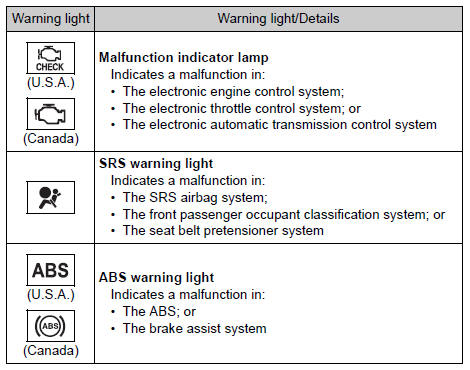
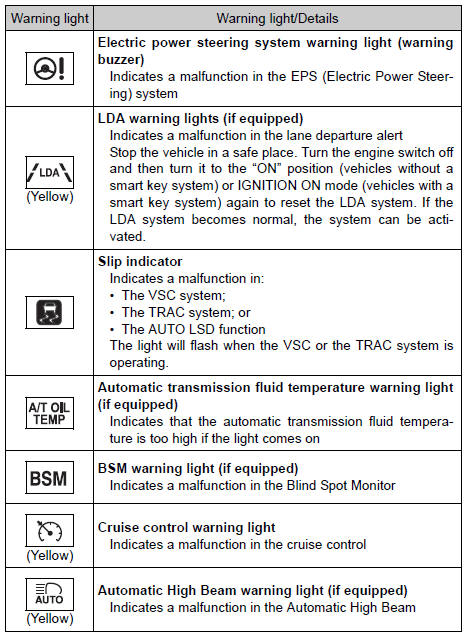
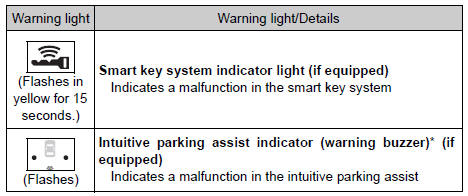
*: The corner and center indicators flash after the indicator for the malfunctioning sensor flashes and the vehicle indicator turns off while the buzzer sounds for approximately 7 seconds.
Follow the correction procedures.
After taking the specified steps to correct the suspected problem, check that the warning light goes off.
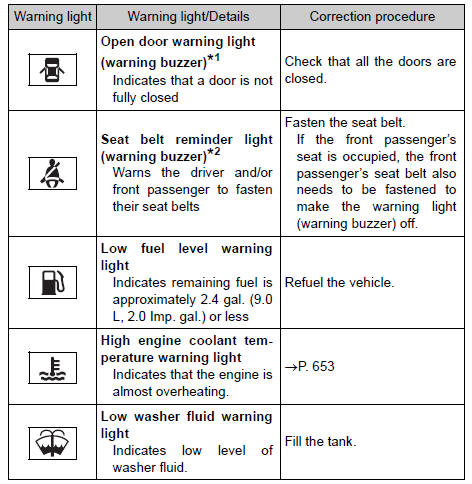
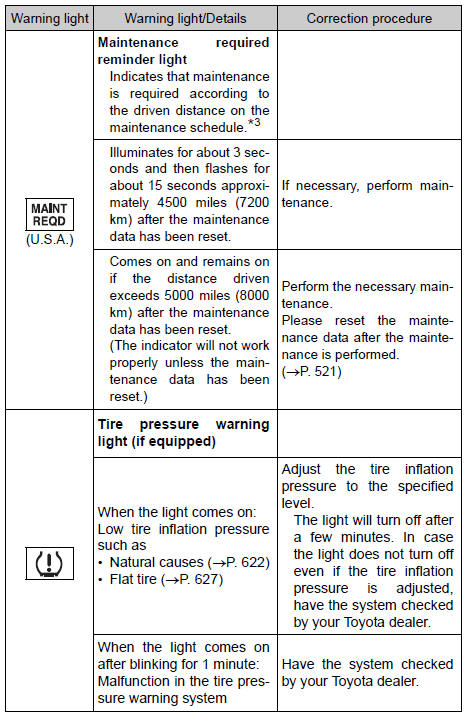
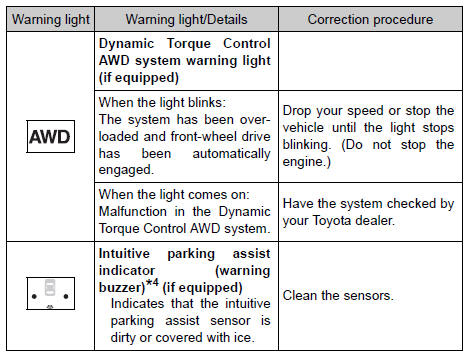
*1: Open door warning buzzer: a buzzer will sound if the vehicle reaches a speed of 3 mph (5 km/h) or more with any door open.
*2: Driver’s seat belt buzzer: the driver’s seat belt buzzer sounds to alert the driver that his or her seat belt is not fastened. Once the engine switch is turned to the “on” position (vehicles without a smart key system) or ignition on mode (vehicles with a smart key system), the buzzer sounds for 6 seconds. If the vehicle reaches a speed of 12 mph (20 km/h), the buzzer sounds once. If the seat belt is still unfastened after 30 seconds, the buzzer will sound intermittently for 10 seconds. Then, if the seat belt is still unfastened, the buzzer will sound in a different tone for 20 more seconds.
Front passenger’s seat belt buzzer: the front passenger’s seat belt buzzer sounds to alert the front passenger that his or her seat belt is not fastened. The buzzer sounds once if the vehicle reaches a speed of 12 mph (20 km/h). If the seat belt is still unfastened after 30 seconds, the buzzer will sound intermittently for 10 seconds.
Then, if the seat belt is still unfastened, the buzzer will sound in a different tone for 20 more seconds.
*3: Refer to the separate “scheduled maintenance guide” or “owner’s manual supplement” for the maintenance interval applicable to your vehicle.
*4: The corner and center indicators turn on and remain on after the indicator for the malfunctioning sensor turns on and the vehicle indicator turns off while the buzzer sounds for approximately 7 seconds.
Follow the correction procedures. (Vehicles with a smart key system)
After taking the specified steps to correct the suspected problem, check that the warning light goes off.
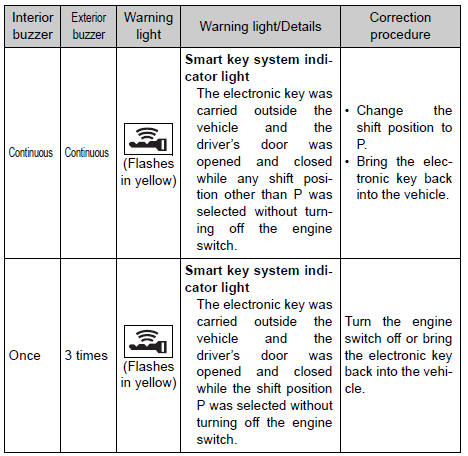
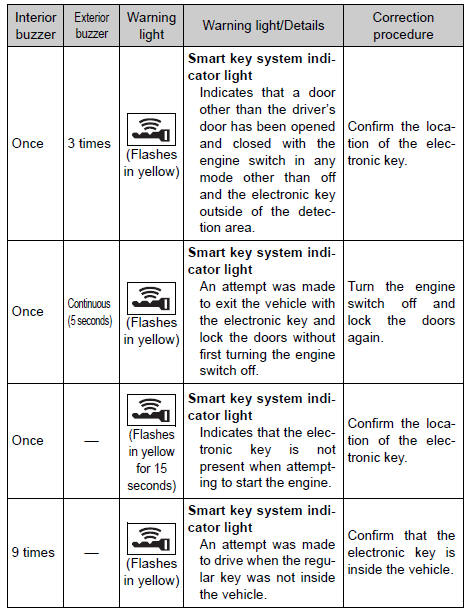
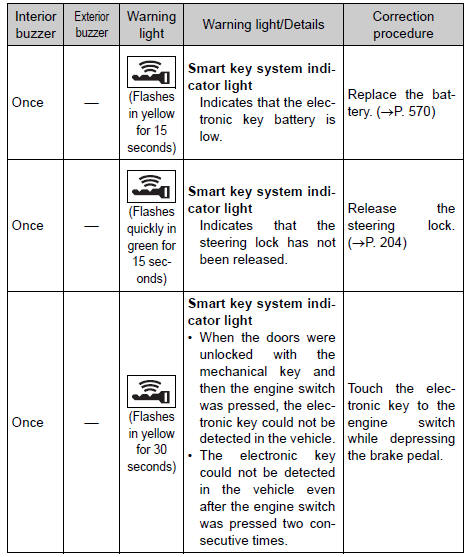
Srs warning light
This warning light system monitors the airbag sensor assembly, front impact sensors, side impact sensors (front door), side impact sensors (rear), driver’s seat position sensor, driver’s seat belt buckle switch, front passenger occupant classification system, “air bag on” indicator light, “air bag off” indicator light, front passenger’s seat belt buckle switch, driver’s seat belt pretensioner, front passenger’s seat belt pretensioner and force limiter, airbags, interconnecting wiring and power sources.
Front passenger detection sensor, seat belt reminder and warning buzzer
If luggage is placed on the front passenger seat, the front passenger detection sensor may cause the warning light to flash and the warning buzzer to sound even if a passenger is not sitting in the seat.
If the malfunction indicator lamp comes on while driving
First check the following:
- Is the fuel tank empty? If it is, fill the fuel tank immediately.
- Is the fuel tank cap loose? If it is, tighten it securely.
The light will go off after several driving trips.
If the light does not go off even after several trips, contact your toyota dealer as soon as possible.
Electric power steering system warning light (warning buzzer)
When the battery charge becomes insufficient of the voltage temporarily drops, the electric power steering system warning light may come on and the warning buzzer may sound.
When the tire pressure warning light comes on (vehicles with the tire pressure warning system)
Check the tire inflation pressure and adjust to the appropriate level. Pushing the tire pressure warning reset switch will not turn off the tire pressure warning light.
The tire pressure warning light may come on due to natural causes (vehicles with the tire pressure warning system)
The tire pressure warning light may come on due to natural causes such as natural air leaks and tire inflation pressure changes caused by temperature.
In this case, adjusting the tire inflation pressure will turn off the warning light (after a few minutes).
When a tire is replaced with a compact spare tire (vehicles with a compact spare tire and the tire pressure warning system)
The compact spare tire is not equipped with a tire pressure warning valve and transmitter. If a tire goes flat, the tire pressure warning light will not turn off even though the flat tire has been replaced with the spare tire.
Replace the spare tire with the standard tire and adjust the tire inflation pressure. The tire pressure warning light will go off after a few minutes.
If the tire pressure warning system is not functioning
The tire pressure warning system will be disabled in the following conditions: (when the condition becomes normal, the system will work properly.)
- If tires not equipped with tire pressure warning valves and transmitters are used
- If the id code on the tire pressure warning valves and transmitters is not registered in the tire pressure warning computer
- If the tire inflation pressure is 73 psi (500 kpa, 5.1 Kgf/cm2 or bar) or higher
The tire pressure warning system may be disabled in the following conditions: (when the condition becomes normal, the system will work properly.)
- If electronic devices or facilities using similar radio wave frequencies are nearby
- If a radio set at a similar frequency is in use in the vehicle
- If a window tint that affects the radio wave signals is installed
- If there is a lot of snow or ice on the vehicle, particularly around the wheels or wheel housings
- If non-genuine toyota wheels are used (even if you use toyota wheels, the tire pressure warning system may not work properly with some types of tires.)
- If tire chains are used
If the tire pressure warning light frequently comes on after blinking for 1 minute (vehicles with the tire pressure warning system)
If the tire pressure warning light frequently comes on after blinking for 1 minute when the engine switch is turned to the “on” position (vehicles without a smart key system) or ignition on mode (vehicles with a smart key system), have it checked by your toyota dealer.
Warning buzzer
In some cases, the buzzer may not be heard because of noisy place or an audio sound.
Customization
The vehicle speed linked seat belt reminder buzzer can be disabled.
Caution
If both the abs and the brake system warning lights remain on
Stop your vehicle in a safe place immediately and contact your toyota dealer. The vehicle will become extremely unstable during braking, and the abs system may fail, which could cause an accident resulting in death or serious injury.
When the electric power steering system warning light comes on
The steering wheel may become extremely heavy.
If the steering wheel becomes heavier than usual when operating, hold firmly and operate using more force than usual.
If the tire pressure warning light comes on (vehicles with the tire pressure warning system)
Be sure to observe the following precautions. Failure to do so could cause a loss of vehicle control and result in death or serious injury.
- Stop your vehicle in a safe place as soon as possible. Adjust the tire inflation pressure immediately.
- If the tire pressure warning light comes on even after tire
inflation pressure
adjustment, it is probable that you have a flat tire. Check the tires.
If a tire is flat, change it with the spare tire and have the flat tire repaired by the nearest toyota dealer.
- Avoid abrupt maneuvering and braking. If the vehicle tires deteriorate, you could lose control of the steering wheel or the brakes.
If a blowout or sudden air leakage should occur (vehicles with the tire pressure warning system)
The tire pressure warning system may not activate immediately.
Caution
Maintenance of the tires (vehicles with the tire pressure warning system)
Each tire, including the spare (if provided), should be checked monthly when cold and inflated to the inflation pressure recommended by the vehicle manufacturer on the vehicle placard or tire inflation pressure label (tire and load information label). (If your vehicle has tires of a different size than the size indicated on the vehicle placard or tire inflation pressure label [tire and load information label], you should determine the proper tire inflation pressure for those tires.) As an added safety feature, your vehicle has been equipped with a tire pressure monitoring system (tpms-tire pressure warning system) that illuminates a low tire pressure telltale (tire pressure warning light) when one or more of your tires is significantly under-inflated. Accordingly, when the low tire pressure telltale (tire pressure warning light) illuminates, you should stop and check your tires as soon as possible, and inflate them to the proper pressure. Driving on a significantly underinflated tire causes the tire to overheat and can lead to tire failure.
Under-inflation also reduces fuel efficiency and tire tread life, and may affect the vehicle’s handling and stopping ability.
Please note that the tpms (tire pressure warning system) is not a substitute for proper tire maintenance, and it is the driver’s responsibility to maintain correct tire pressure, even if under-inflation has not reached the level to trigger illumination of the tpms low tire pressure telltale (tire pressure warning light).
Your vehicle has also been equipped with a tpms (tire pressure warning system) malfunction indicator to indicate when the system is not operating properly. The tpms (tire pressure warning system) malfunction indicator is combined with the low tire pressure telltale (tire pressure warning light). When the system detects a malfunction, the telltale will flash for approximately one minute and then remain continuously illuminated.
This sequence will continue upon subsequent vehicle start-ups as long as the malfunction exists. When the malfunction indicator is illuminated, the system may not be able to detect or signal low tire pressure as intended.
Caution
Tpms (tire pressure warning system) malfunctions may occur for a variety of reasons, including the installation of replacement or alternate tires or wheels on the vehicle that prevent the tpms (tire pressure warning system) from functioning properly. Always check the tpms (tire pressure warning system) malfunction telltale after replacing one or more tires or wheels on your vehicle to ensure that the replacement or alternate tires and wheels allow the tpms (tire pressure warning system) to continue to function properly.
Notice
To ensure the tire pressure warning system operates properly (vehicles with the tire pressure warning system)
Do not install tires with different specifications or makers, as the tire pressure warning system may not operate properly.
 Fuel pump shut off
system
Fuel pump shut off
system
To minimize the risk of fuel leakage when the engine stalls or
when an airbag inflates upon collision, the fuel pump shut off
system stops the supply of fuel to the engine.
Follow the procedure bel ...
 If you have a flat tire
If you have a flat tire
Your vehicle is equipped with a spare tire. The flat tire can be
replaced with the spare tire.
For details about tires
Caution
If you have a flat tire
Do not continue driving with a flat tire.
...
Other materials:
Types of child restraints
Child restraint systems are classified into the following 3 types
according to the age and size of the child:
Rear facing „o infant seat/convertible
seat
Forward facing „o convertible
seat
Booster seat
Selecting an appropriate child restraint system
Use a child restraint ...
Driving the vehicle
The following procedures
should be observed to
ensure safe driving:
Driving procedure
â– Driving
1. With the brake pedal
depressed, shift the shift
lever to D.
2. Release the parking brake.
If the parking brake is in automatic
mode, the parking brake will be
released automatically.
3. Gradually re ...
Data list / active test
Read data list
Hint:
Using the intelligent tester's data list allows switch,
sensor, actuator, and other item values to be read
without removing any parts. Reading the data list
early in troubleshooting is one way to save time.
Notice:
In the table below, the values listed under "no ...
